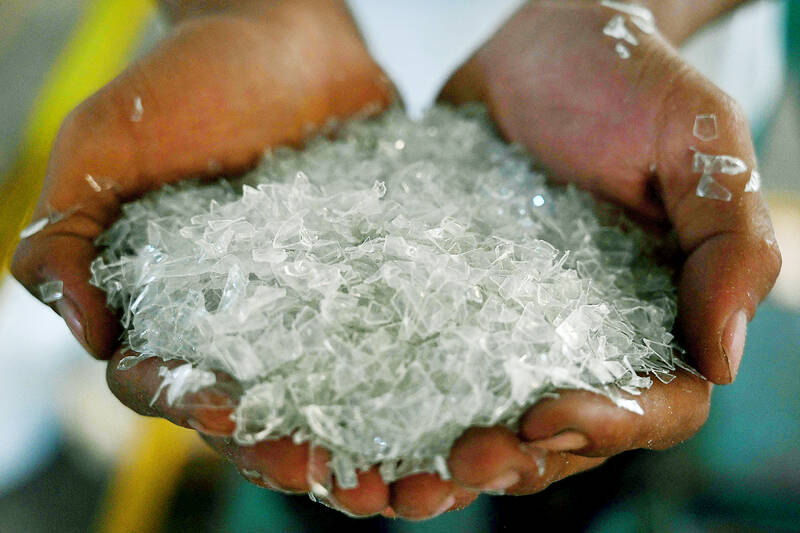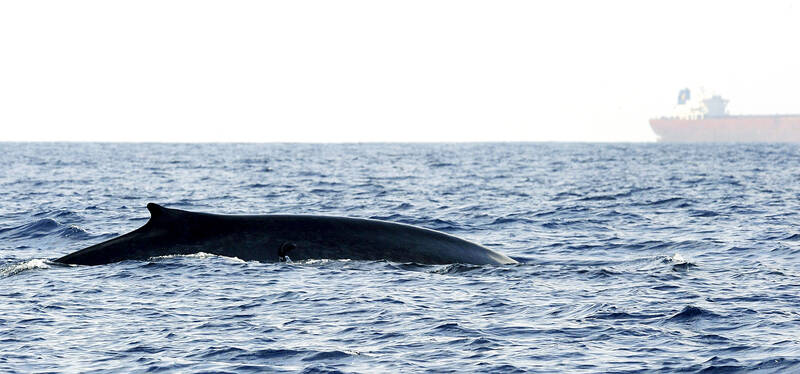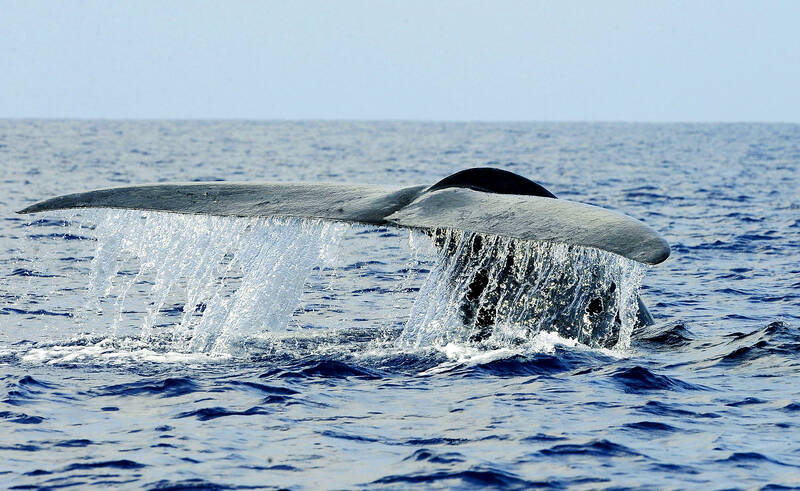As Earth’s largest animals, blue whales are mighty big eaters, gulping tons of food each day. They also now are ingesting huge amounts of plastic, according to scientists, due to the alarming volume of tiny particles of pollution choking the oceans.
Researchers on Tuesday presented an estimate of the amount of microplastics ingested by three species of baleen whales — blue, fin and humpback — off the US Pacific coast, detailing an issue posing uncertain health concerns for these marine mammals.
As baleen whales, these species are filter-feeders. They strain food — shrimp-like crustaceans called krill and other small prey -- from the seawater using baleen plates in the mouth made of keratin, the substance found in people’s fingernails.

Photo: AFP
Blue whales, according to the study, may swallow roughly 10 million microplastic pieces daily, or up to about 43.5 kg of plastic. For fin whales, whose main prey also is krill, the estimated daily tally is about 6 million microplastic pieces, or up to 25.8kg of plastic.
Some humpback whales specialize in krill and some favor eating small schooling fish. Krill-favoring humpbacks, according to the study, may ingest about 4 million microplastic pieces (up to 17.2kg of plastic) daily, while those favoring fish may take in a much smaller amount, roughly 200,000 pieces (up to a couple of pounds of plastic).
“In the moderately polluted waters off the US West Coast, baleen whales may still be ingesting millions of microplastics and microfibers per day,” said Stanford University marine biologist Matthew Savoca, a co-author of the study published in the journal Nature Communications.

Photo: AFP
“Also we find that the vast majority — 99 percent — are via their prey that have previously ingested plastic and not from the water they filter,” Savoca added.
The study illustrated how baleen whales may be at an elevated risk for microplastics ingestion as a result of their mode of feeding, the quantity of their food intake, and their habitat overlapping with polluted areas such as the California Current that flows south along North America’s western coast.
Blue whales can reach a maximum of about 30 meters long, fin whales about 24 meters and humpback whales about 15 meters.

Photo: AFP
The researchers estimated the daily microplastic ingestion by examining the foraging behavior of 126 blue whales, 65 humpback whales and 29 fin whales using measurements from electronic tag devices suction-cupped to the animal’s back, with a camera, microphone, GPS locator and an instrument that tracks movement. They then factored in the concentrations of microplastics in the California Current.
As a study published last year based on the same whales off the US West Coast showed, blue whales eat about 10-20 tons of krill daily, while fin whales eat 6-12 tons of krill and humpback whales eat 5-10 tons of krill or 2-3 tons of fish.
The new study found that the whales primarily feed at depths of 50–250 meters, coinciding with the highest measured microplastic concentrations in the open-ocean ecosystem.
Microplastics are particles of plastic debris — less than 5mm long — arising from the disposal and breakdown of various consumer products and industrial waste, with their concentrations in the oceans mounting in recent decades. The potential health effects on the whales from ingesting it is not well understood.
“While this was not the focus of our study, other research has shown that if plastics are small enough they can cross the gut wall and get into internal organs, though the long-term effects are still unclear. Plastics can also release chemicals that are endocrine disruptors,” said marine biologist Shirel Kahane-Rapport of California State University, Fullerton, lead author of the study.

June 2 to June 8 Taiwan’s woodcutters believe that if they see even one speck of red in their cooked rice, no matter how small, an accident is going to happen. Peng Chin-tian (彭錦田) swears that this has proven to be true at every stop during his decades-long career in the logging industry. Along with mining, timber harvesting was once considered the most dangerous profession in Taiwan. Not only were mishaps common during all stages of processing, it was difficult to transport the injured to get medical treatment. Many died during the arduous journey. Peng recounts some of his accidents in

“Why does Taiwan identity decline?”a group of researchers lead by University of Nevada political scientist Austin Wang (王宏恩) asked in a recent paper. After all, it is not difficult to explain the rise in Taiwanese identity after the early 1990s. But no model predicted its decline during the 2016-2018 period, they say. After testing various alternative explanations, Wang et al argue that the fall-off in Taiwanese identity during that period is related to voter hedging based on the performance of the Democratic Progressive Party (DPP). Since the DPP is perceived as the guardian of Taiwan identity, when it performs well,

A short walk beneath the dense Amazon canopy, the forest abruptly opens up. Fallen logs are rotting, the trees grow sparser and the temperature rises in places sunlight hits the ground. This is what 24 years of severe drought looks like in the world’s largest rainforest. But this patch of degraded forest, about the size of a soccer field, is a scientific experiment. Launched in 2000 by Brazilian and British scientists, Esecaflor — short for “Forest Drought Study Project” in Portuguese — set out to simulate a future in which the changing climate could deplete the Amazon of rainfall. It is

The Taiwan People’s Party (TPP) on May 18 held a rally in Taichung to mark the anniversary of President William Lai’s (賴清德) inauguration on May 20. The title of the rally could be loosely translated to “May 18 recall fraudulent goods” (518退貨ㄌㄨㄚˋ!). Unlike in English, where the terms are the same, “recall” (退貨) in this context refers to product recalls due to damaged, defective or fraudulent merchandise, not the political recalls (罷免) currently dominating the headlines. I attended the rally to determine if the impression was correct that the TPP under party Chairman Huang Kuo-Chang (黃國昌) had little of a